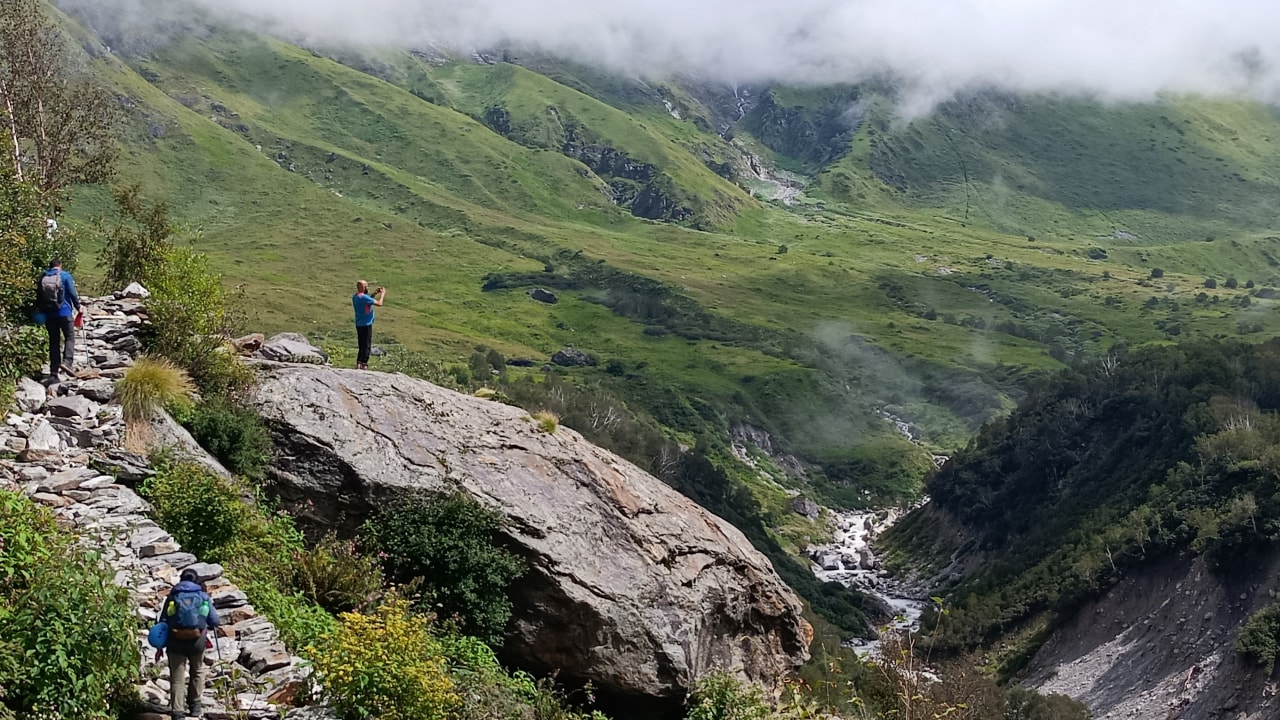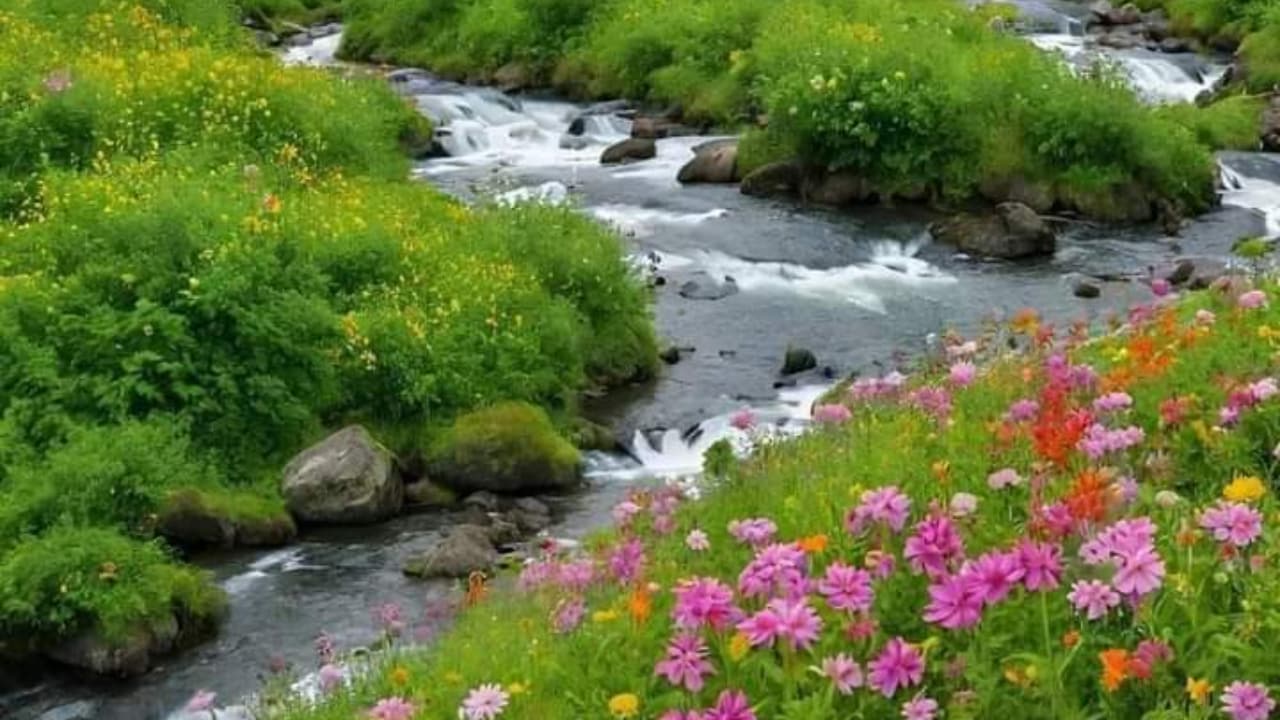The Valley of Flowers Trek in Uttarakhand is a UNESCO World Heritage site, famous for rare Himalayan blooms, waterfalls, and the sacred Hemkund Sahib. Discover the best time, highlights, and tips for this unforgettable trek.
The Valley of Flowers Trek is one of the most iconic treks in India. Even if you’ve never trekked before, chances are you’ve heard of this magical valley in Uttarakhand. Every year, trekkers and travellers from across the world visit this UNESCO World Heritage Site, especially during the monsoon months when wildflowers burst into full bloom, painting the meadows in every imaginable colour.
Some of these flowers are so rare that you may never see them blooming like this anywhere else in the world. But the trek isn’t just about flowers. It’s about the rivers, waterfalls, alpine meadows, spiritual journeys, and a cultural experience that leaves you transformed.
Stepping Into Nature’s Wonderland
Nestled deep between tall mountains, the valley is crisscrossed by the Pushpavati River, which flows gracefully through its heart. The trail runs alongside this river, eventually leading to a breathtaking viewpoint of a glacier at the far end.
As you dip your feet into the icy mountain streams, time seems to slow down. During the monsoon, every step ahead bursts with colours, with flowers so perfectly arranged that you wonder if nature has painted the valley by hand.
But the trek’s essence is not just natural; it’s spiritual too. A climb to Hemkund Sahib, a sacred lake perched over 14,000 ft above sea level, is one of the toughest yet most rewarding parts of the journey. As you climb, the landscape transforms , forests give way to alpine meadows, and in August, you even stumble upon the rare Brahma Kamal. At the top lies a glacial lake, with a serene Gurudwara sitting by its edge. Standing there, with mist swirling around the peaks, is an unforgettable moment of peace.

How the World Came to Know the Valley of Flowers?
The story of its discovery is as magical as the valley itself. In 1931, British mountaineer Frank Smythe and his team were returning from an expedition to Mt. Kamet when they lost their way. They wandered into this hidden valley, fed by the Pushpavati Nala.
What they saw left them awestruck, an endless stretch of wildflowers in full bloom. Smythe later immortalized it in his book, calling it the “Valley of Flowers”, and the name stayed forever.
In 1980, the area was declared the Valley of Flowers National Park. Later, in 2002, it was recognized as a UNESCO World Heritage Site, securing its place on the global trekking map.
5 Experiences You Shouldn’t Miss on the Valley of Flowers Trek
Waterfalls Along the Trail
While flowers take the spotlight, the trek surprises you with its monsoon-fed waterfalls. Just after Poolna, streams tumble down steep cliffs into the Pushpavati. The most striking one appears right at the valley’s entrance, where a wooden bridge lets you stand and watch the water crashing below. Another lies on the way to Hemkund Sahib, marking the beginning of the tough zigzag climb.
The Blue Poppy Viewpoint
On the way up from Ghangaria, before entering the valley, you reach a scenic viewpoint. Known as the Blue Poppy Point, it offers a panoramic view of the lush green valley, the Pushpavati River, and the distant Gauri Parvat and Tipra Bamak Glacier.
The Valley of Flowers
The crown jewel itself, a carpet of flowers stretching for kilometers. From orchids and primulas to the rare Himalayan blue poppy, every few steps reveal a new species. The cool breeze carries their fragrance, making the valley feel alive.
The Climb to Hemkund Sahib
A tough 6 km ascent with a 4,000 ft gain, this trail tests your stamina but rewards you with sweeping views of the valley from above. At the top, the glacial Hemkund Lake reflects the surrounding peaks and the white-domed Gurudwara, a moment of serenity trekkers never forget.
A Cultural Journey
The trek is not just about nature but also faith. Pilgrims of all ages, including children and elderly devotees, undertake the steep climb to Hemkund Sahib. The spirit of service is remarkable, volunteers serve hot tea and meals at the Gurudwara, offering warmth and kindness at freezing altitudes.

Best Time to Visit the Valley of Flowers
- July: The valley is lush green. Flowers begin to bloom mid-July. Early July offers greenery, melting snow, and fewer crowds.
- August: Peak flowering season. The valley bursts into colours, making it the best month to visit.
- September: The flowers begin to fade, but snow-dusted peaks and crisp skies make it a serene experience.
Stay Options in Valley of Flowers Trek
- Govindghat: Base point for the trek with hotels and guesthouses.
- Ghangaria: The midway base camp. You’ll find lodges, camps, and dhabas here, but don’t expect luxury, it’s basic and functional.
What to Pack for Valley of Flowers?
- Good trekking shoes (waterproof preferred)
- Rain gear (poncho/jacket) as it rains frequently in monsoon
- Warm clothes (temperatures drop sharply at night)
- Daypack for essentials (snacks, water, camera, medical kit)
- Trekking poles for the Hemkund climb

Tips for Trekkers
- Train with stamina-building exercises before the trek.
- Carry enough cash; ATMs are unreliable in the region.
- Avoid littering, it’s a protected National Park.
- Start early each day to avoid afternoon rains.
- Respect local culture and spiritual sites.
The Valley of Flowers Trek is more than just a Himalayan trek, it’s an experience that blends natural wonder, adventure, and spiritual peace. Whether you go for the rare flowers, the mighty waterfalls, the climb to Hemkund Sahib, or simply to soak in the silence of the mountains, this trek will stay etched in your memory.
